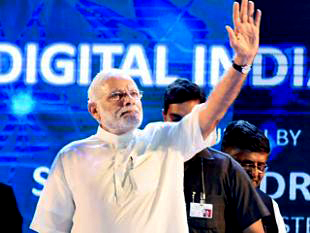New Delhi, Jul 2: Prime Minister Narendra Modi on Wednesday launched the "Digital India Week" as part of the larger initiative to empower the people and extend services better with the use of information technology and its tools.
 The prime minister calculated Rs 4.5 lakh crore investment has been committed for Digital India and employment for 18 lakh people.
The prime minister calculated Rs 4.5 lakh crore investment has been committed for Digital India and employment for 18 lakh people.
The prime minister also unveiled a logo for Digital India, an umbrella programme that seeks to transform India into a digitally-empowered, knowledge economy with a host of initiatives for a synchronized and coordinated engagement of the government and its agencies.
For this scheme, the prime minister has already been named chairman of a high-powered monitoring committee and all existing and ongoing e-governance initiatives will be revamped to align them with the larger principles of "Digital India", according to an official statement.
The larger goal of Digital India includes broadband connectivity in all panchayats, Wi-fi in all the schools and universities and public wi-fi hotspots in all important cities by 2019. It will be deployed in delivering services in areas like health, education, agriculture and banking.
The vision is centred on three key areas:
— Digital infrastructure as a utility to every citizen
— Governance and service on demand
— Digital empowerment of Citizens
Following are the highlights of the corporate pledges:
Reliance Industries plans to invest about Rs 2.5 lakh crore ($39.3 billion) in digital initiatives, chairman Mukesh Amabani said on Wednesday. However, he did not give a timeline.
"I believe digital India will be a huge success because of the adoption of technology by the youth of India," Ambani said at the event.
"Digital India as we have seen empowers them to fulfill their aspirations. We at Reliance will invest over Rs 250,000 crore across the Digital India pillars," he said, adding, "I estimate Reliance’s 'Digital India' investments will create employment for over 500,000 people."
He said his group, under the Reliance Jio platform, will roll out an internet protocol-based wireless broadband infrastructure across all 29 states in India. Reliance Jio will also set up a nationwide distribution network for 150,000 small vendors to sell and service devices.
Aditya Birla Group promised to invest $7 bn in the next five years in network rollout and infra and digital space. Chairman KM Birla also announced that his company was working to set up a 100-acre digitally enabled township near Mumbai.
Bharti Airtel's Sunil Mittal committed to spend in excess of Rs 100,000 in the next five years. Mittal also said the company will take 4G to the masses. The Bharti chairman also said that his firm will make meaningful contribution towards the Digital Indian initiative. "We will also ensure providing services such as e-health and e-education to Indian citizens," he said.
Tata Group's Cyrus Mistry said the company will hire 60,000 IT professionals this year.
Speaking on the occasion, Anil Ambani's Reliance Group today committed to invest about Rs 10,000 crore over the next few years to expand its presence across digital, cloud computing and telecom space.
Reliance Group, which already has India's fourth largest telecom company in Reliance Communication, plans to achieve full deployment of next generation content and Cloud Delivery Network by the year end, Ambani said at the launch of Digital India Week by Prime Minister Narendra Modi in New Delhi.





Comments
Add new comment